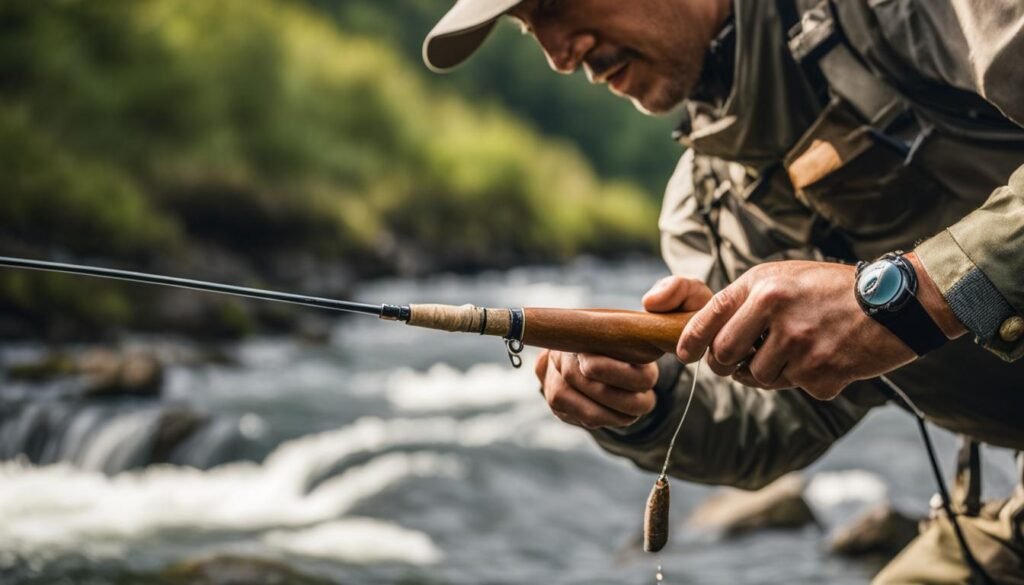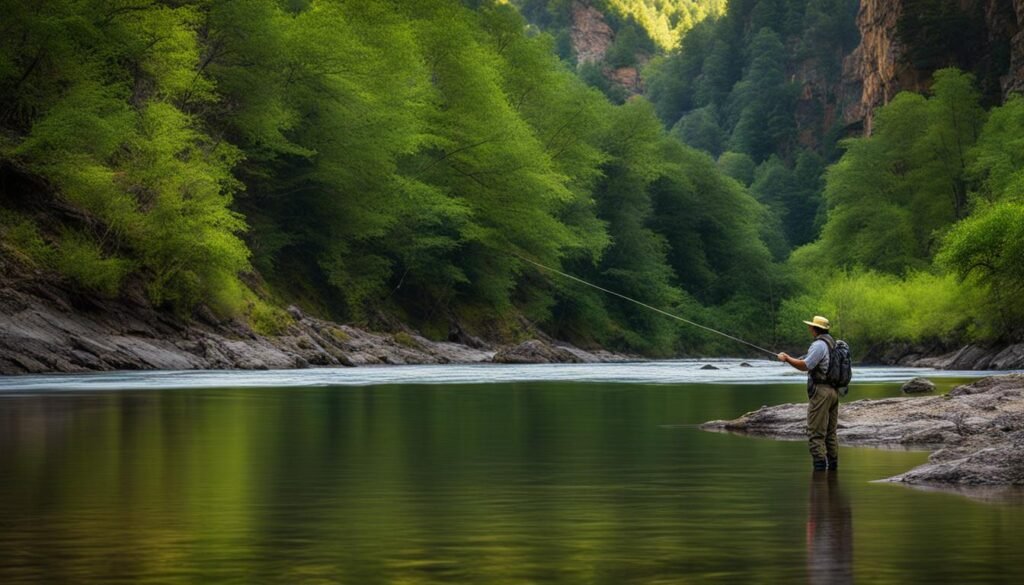Euro nymphing is a highly effective fly fishing method that has gained popularity in recent years. It involves fishing with weighted nymphs on a tight line, allowing for precise control and sensitivity. This technique has been proven to out fish traditional indicator nymphing in many situations. In this ultimate guide, we will explore the techniques, tips, and tricks to master euro nymphing and enhance your fly fishing experience.
Key Takeaways:
- Euro nymphing is a highly effective fly fishing method that uses weighted nymphs on a tight line.
- It offers precise control and sensitivity, outfishing traditional indicator nymphing in many situations.
- Choosing the right gear, including a specialized euro nymphing rod and versatile flies, is important for success.
- Euro nymphing requires a different casting technique and focuses on accuracy and presentation.
- Techniques such as dead drifting and active nymphing can be employed for successful euro nymphing.
The Difference Between Euro Nymphing and Indicator Nymphing
Euro nymphing and indicator nymphing are two distinct styles of nymphing in the world of fly fishing. While both techniques focus on presenting nymphs to trout, they differ in rigging and fly choices.
Euro Nymphing:
- Eliminates the use of a suspended indicator
- Relies on a continuous leader tied inline
- Provides extremely sensitive strike detection
- Allows for precise control and better depth presentation
With euro nymphing, the absence of an indicator means there are no dead points in the rig. This makes it easier to detect subtle strikes and increases overall sensitivity. The continuous leader allows for better control over the nymphs’ depth and presentation, resulting in a more natural drift.
Indicator Nymphing:
- Uses a suspended indicator, split shot, and tapered leader
- Relies on the indicator to track the nymphs
- Offers versatility in adjusting the nymph’s depth
- Allows for easy visibility of strikes
Indicator nymphing utilizes a suspended indicator, usually a bobber or a dry fly, to track the nymphs. Anglers can easily adjust the nymph’s depth by adding or removing split shot. The indicator provides excellent visibility when a trout takes the nymph, making it easier to detect strikes.
Deciding whether to use euro nymphing or indicator nymphing depends on various factors such as water conditions, trout behavior, and personal preference. Both techniques have their advantages and excel in different situations. By understanding the differences between euro nymphing and indicator nymphing, you can choose the most appropriate method for your fly fishing adventures.
Choosing the Right Euro Nymphing Gear
Euro Nymphing Rod
A specialized euro nymphing rod is essential for better line control and sensitivity. Look for a rod that is typically 10 to 11 feet in length, as this will allow you to reach those hard-to-reach spots and maintain a tight line connection with your nymphs.
Leader Selection
The leader is a crucial part of your nymphing setup. It should be chosen based on versatility and sensitivity. Opt for a leader that is longer and thinner to ensure better line control and strike detection.
Euro Nymphing Flies
Choosing the right flies is paramount in euro nymphing. Euro-style flies with tungsten beads or lead incorporated are essential for getting your nymphs down to the desired depth quickly. Make sure to have a variety of fly weights and patterns in your fly box to adapt to different water types and conditions.
Mastering the Euro Nymphing Cast

Casting in euro nymphing may require a different approach compared to traditional fly casting, but with practice, you can master this technique. The key to a successful euro nymphing cast lies in understanding the nuances of casting a heavy nymph and employing the right techniques. Here are some tips to help you improve your euro nymphing cast:
- Start with a smooth and controlled casting stroke. It’s important to avoid using excessive force or power, as it can result in sloppy casts. Instead, focus on a fluid motion with precise control.
- Timing is crucial. In euro nymphing, you want to cast the nymphs close to your position, so they have less time to sink before reaching the target zone. This requires a shorter casting stroke with a crisp stop at the end.
- Master the art of line management. Keeping the line off the water and under tension is essential for strike detection. Use your non-dominant hand to manipulate the line and ensure it doesn’t impede the drift of your nymphs.
Adjusting for different water conditions
- Fast water: In fast-flowing water, a shorter, more compact cast is ideal. You may need to use a stronger stroke to counteract the current and get your nymphs down quickly.
- Slow water: In slow-moving water, a longer cast with a more delicate presentation is necessary. Focus on a smooth, controlled stroke to avoid spooking the fish.
- Obstacles: When casting around obstacles such as rocks or submerged branches, accuracy is key. Practice your accuracy casting techniques and be prepared to make quick adjustments.
Techniques for depth control
- Weighted flies: Use flies with tungsten beads or lead incorporated to add weight and get your nymphs to sink faster.
- Adjusting leader length: Experiment with different leader lengths to find the right balance between depth control and sensitivity. Shorter leaders are ideal for shallow water, while longer leaders are better suited for deeper sections.
- Adding split shot: When fishing in deeper or faster water, adding split shot above the leader can help get your nymphs down to the desired depth.
Fishing Techniques and Strategies for Euro Nymphing
Euro nymphing offers a range of techniques and strategies that can significantly improve your success in catching trout. One of the key differences in euro nymphing is the use of a sighter to track the nymphs instead of a traditional indicator. A sighter is a high-visibility piece of monofilament or colored nylon that allows you to detect strikes and monitor the drift of your flies.
When fishing with a sighter, it is important to learn how to read it effectively. Watch for any movement or hesitation in the sighter, as these can indicate a strike. By adjusting the angle and tension of the sighter, you can maintain control over the drift and ensure your nymphs are presented in a natural manner.
There are various euro nymphing techniques you can employ depending on the conditions and the behavior of the fish. The dead drift technique involves allowing the nymphs to flow naturally with the current, imitating the behavior of natural insects. Active nymphing, on the other hand, involves imparting subtle movements to the flies to trigger a response from the trout. Additionally, inverting the sighter can create a unique presentation that can entice strikes from wary fish.
Key Points:
- Use a sighter instead of a traditional indicator to track the nymphs.
- Learn to read the sighter for strikes and monitor the drift.
- Experiment with dead drift, active nymphing, and inverting the sighter techniques.
Additional Resources for Euro Nymphing
If you’re eager to dive deeper into the world of euro nymphing, there are plenty of resources available to educate and inspire you. Whether you prefer listening to podcasts, reading articles, or watching instructional videos, these resources will help take your euro nymphing skills to the next level.
There are numerous euro nymphing podcasts hosted by experienced anglers and experts in the field. These podcasts provide valuable insights, tips, and interviews, allowing you to learn from the best in the business. Tune in during your commute or while you’re on the water to stay connected with the latest euro nymphing trends and techniques.
If you prefer written content, there is a wealth of euro nymphing articles available online. These articles cover a wide range of topics, including rigging techniques, gear selection, fly patterns, and more. By reading these articles, you can gain a comprehensive understanding of euro nymphing and discover new strategies to test on the water.
For visual learners, instructional videos are a fantastic resource. Many expert anglers share their knowledge through detailed video tutorials, demonstrating casting techniques, drift control methods, and fly manipulation. By watching these videos, you can observe the finesse and nuances of euro nymphing in action, helping you refine your own skills.

